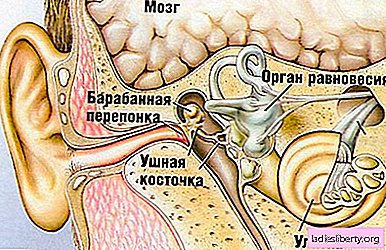
Otitis is an inflammatory process of the middle ear. The ear itself consists not only of the auricle, but also of the external auditory canal, the eardrum that separates the passage from the middle ear. The middle ear is a tiny cavity with a bone mechanism that transmits a sound wave to the inner ear, which in turn transforms sound waves into nerve impulses entering the brain. Otitis media is considered one of the most common causes of hearing loss, and in the worst case, complete loss of hearing may occur.
Otitis - causes
Otitis in most cases occurs as a result of a respiratory disease, in which there is edema of the Eustachian tubes connecting the pharynx to the middle ear. As a result, fluid collects in the middle ear, and viruses and bacteria multiply in it. Otitis is most often found in children under the age of seven, as their Eustachian tubes are straighter and shorter than in adults.
Otitis media - symptoms
Inflammation of the middle ear and acute purulent otitis media are characterized by aching or shooting pain in the ear, fever, as well as purulent discharge from the external auditory canal. Usually this disease begins with a sharp shooting pain (small children who still cannot speak, when the pain intensifies - they cry, and subside when the pain subsides). A few days after the temperature rises, purulent discharge appears in the external auditory canal. At the same time, the patient's condition improves, pain in the ear region decreases or completely disappears and the temperature drops. The appearance of purulent discharge in the external auditory canal is due to the fact that they break through the eardrum. This indicates a favorable development of the process and against the background of proper therapy, the hole in the membrane will be delayed, the hearing will not be affected. However, not everything goes so smoothly. Sometimes pus cannot find a way out, which may be the reason for the spread of internal infection in the cranial cavity. In such cases, a high probability of developing an abscess of the brain or meningitis. Therefore, when the most minor symptoms of otitis media appear, you should immediately contact an ENT specialist (otolaryngologist) in order to conduct timely treatment.
Otitis is characterized by symptoms such as fever, hearing loss, pus leakage, and earache. Most often, this disease is a complication after a cold. Kids cry, touch their ears, sleep poorly, turn their heads. The baby is likely to give up breasts, as swallowing and sucking cause pain. If you click on the protrusion on the front side of the auditory opening - the tragus, then the pain will intensify.
Otitis - diagnosis
All these symptoms indicate that you need to consult an otolaryngologist as soon as possible. After all, only a specialist will be able to distinguish otitis media from other diseases that have similar symptoms, and will prescribe the correct treatment. For diagnosis, the doctor uses a special tool - an otoscope. With inflammation of the middle ear, the eardrum is colored yellow or red and takes on a convex shape. Also, during the examination, the doctor determines whether there is fluid or pus in the middle ear and whether the patient’s hearing has decreased.
Otitis - treatment and prevention
Only a doctor can establish the correct diagnosis and prescribe adequate treatment. In this case, you just can not do without the use of medications. Treatment of otitis media lasts for more than ten days and is complex. The patient needs complete peace, so as not to provoke the possibility of complications. A specialized antibiotic is necessarily prescribed to effectively eliminate the causative agents of otitis media. Antibiotics can be in drops (Otipax, Sofradex) and in tablets (Cifran, Flemoklav Solutab), but this is only at the discretion of the doctor, because only he can decide which drug should be used.
For the prevention of otitis media, it is necessary to regularly conduct hardening procedures, which will invariably have a beneficial effect on strengthening immunity. It is also necessary to maintain humidity and air temperature in the room, which should not be higher than 18 degrees Celsius.











